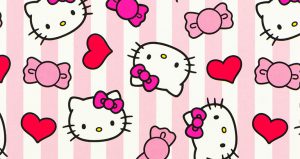Who is Hello Kitty?
An adorably innocent cartoon character? A symbol of female oppression? Or, alternatively, a feminist icon?
It’s nearing five decades since her debut appearance on a vinyl coin purse in November 1974 and Hello Kitty’s status and symbolism continue to be hotly disputed.
The root of the controversy surrounding this five apples tall, 3rd grade, blood type A, cartoon kitten? Put simply, it is the consequence of the decision to depict Kitty without a mouth and, as such, without a voice.
In an era where the struggle for women to have their voices heard and known continues, it can be difficult to understand why an intentionally voiceless female character can still be considered a relevant, cult figure.
Hello Kitty’s creators, Sanrio, suggest that her strength and popularity lies in this distinct feature (or lack of), with Kitty thought to be speaking for the heart. This, according to Sanrio, is a powerful device that allows Kitty to be relevant to all. Fans are able to project any thought, feeling, or emotion onto her. When fans feel sad, so does Kitty; when fans feel happy, so does Kitty.
Is this simply evidence of Kitty’s empathetic nature, aligning with the idea that she is somewhat anthropomorphic? Or is this a romanticised depiction of the expectation for females to be compliant?
This raises the question as to whether, had Hello Kitty been a male, he would have been depicted without a mouth.

Considering Sanrio’s argument that this allows Hello Kitty to function as an international ambassador, it is also worth contemplating whether there is a strength to be recognised in her lack of voice?
The Japanese Tourism Board seemed to think so when, in 2008, they honoured Kitty as an ambassador for Japan in China and Hong Kong, a move underpinned by a desire to improve often fraught relations between the nations.
As did UNICEF, when they awarded Kitty the title ‘Special Friend of the Children,’ corroborating the suggestion that is in Kitty’s neutrality that she remains relevant and relatable to all. Including, in this instance, children facing some of the world’s most dispiriting circumstances.
The debate is rich and multifaceted, with Hello Kitty continuing to function as a ‘polarising cult figure,’ according to TIME magazine. Whatever your perspective on swearing an oath to the cult of Hello Kitty (we’d love to hear your thoughts in the comments section below), one thing is for sure, Hello Kitty has made a significant impact on the world and she’s here to stay!






































